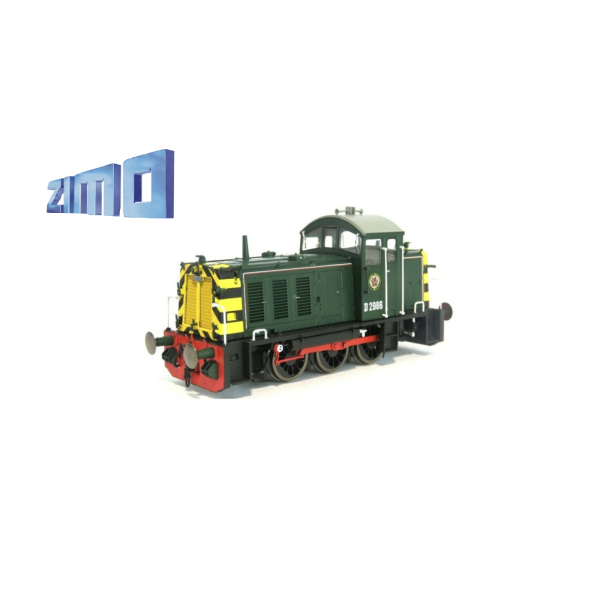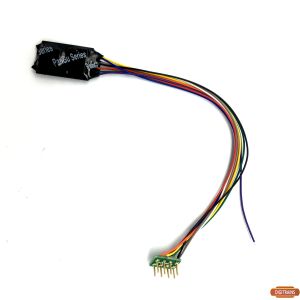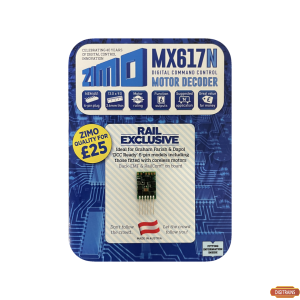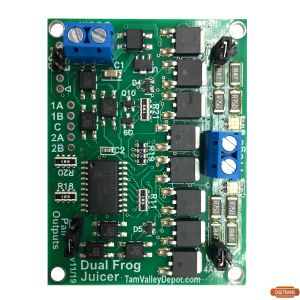Class 07 ProtoDrive SL Enhanced. User Notes
Engine Start Up Options The sound is switched on/off and the engine started and stopped with F key 1 Your decoder has the Priming Pump sound assigned to F key 14 which will operate prototypically with the engine sounds off. This allows you to choose when to use it and your required duration. (Note: In order to obtain the prototypical sequence of sounds before a Cold Start you should engage F14 for as long as you wish and then disengage immediately before engaging F1). You can choose a Cold Start, which exhibits a longer period of engine cranking before the engine fires then a sustained period of ‘hunting’ whilst idling, or a Warm Start where the engine fires immediately and into a ‘warm idle’.
Cold Start: Engage F key 14 before using F key 1 to start the engine. After starting the engine, the decoder will continue playing the ‘Cold Idle’, an irregular idling sound as long as this F Key is engaged. The model will not respond to the throttle whilst this is ongoing so you will need to release F key 14 before driving is possible. When F key 14 is disengaged the idle sound will transition to the steady Warm Idle sound at which point it will be possible to drive the loco.
Warm Start: Disengage F key 14 before using F key 1 to start the engine. The loco may be driven as soon as the Warm Idle sound begins.
Throttle Response Scheme. As supplied, the decoder will produce the sounds of a Class 07 with a train on the hook. After the selected start-up routine the loco will stand with the diesel engine, the Prime Mover (PM), ticking over at idle. The sounds will respond to the throttle control in the following way: Select speed step 1. The brakes will release, the PM will increase power to get the loco moving, and will continue until at higher speed, a further ramp up will be initiated until the final high speed running sounds begin. The precise speed steps will depend upon your model, so I suggest you make a note of the actual figures for your later use. The sounds will spool down at similar points on deceleration. The model can be driven in this way without ever needing to use any control other than the throttle .
For those of you who prefer something more immersive, in this custom version there are extra control features to further enhance your driving pleasure.
Drive Engaged In the real locos drive must be engaged (and brakes released) before it can be moved. This results in a slightly higher tick-over speed. You can, optionally, simulate this by engaging F key 8 before operating the throttle. The engine note will rise but the model will not move. When the throttle is opened, the brake release sound will be heard and the loco will move
Coasting No matter what actual speed your model is travelling at, or which engine note range is playing, reducing the throttle by 10 speed steps (of 128) will spool down the engine sounds to ‘Coasting’ The coasting sound will continue until you accelerate; at which point the sounds will change to those relevant to the current speed. Alternatively, to force the engine to play idling sounds, or to avoid engine ramp up when pottering about the yard, use F6 at any time Notch Down During any driving sound ‘loop’, at any speed, it is possible to cause the engine power to spool down to the level immediately below. This is easily achieved by reducing the speed by one step only E.g., if the loco is playing power band 3 sounds, reducing speed with your throttle by one step will cause the sound to immediately spool down to the sound of power band 2, if in power band 1, it will spool down to idle. Acceleration of one speed step or more will immediately ramp the sound back up to the higher power. So you can now, at any road speed, vary the engine note by reducing or adding a single speed step.
Heavy Train/Light Engine Modes The default setting is for ‘heavy train’. Inertia is high so acceleration (and deceleration) is restricted. Activated by F key 5, Light Engine mode enables a reduced inertia setting to allow more rapid acceleration typically possible if there are no vehicles attached. F key 5 can be operated at any speed to give another way in which the engine sounds at a given road speed may be modified instantly. You can use this feature at any time. (Hint: It can be used to enhance brake force applied with F key 2
Dynamic Inertia A combination of new features is included in the automatic operation of the throttle which will affect how the model responds to your control inputs. The operation is identical in either ‘heavy’ or ‘light’ mode. Put in simple terms, the wider you open the power controller, the quicker the engine sounds ramp up and for the first time on any decoder, the acceleration rate increases correspondingly. What does this mean in practice? If you use your controller’s throttle gently, with modest speed step increases, then the engine will rise and fall automatically and the model will accelerate according to the momentum setting. This is by default high for ‘heavy’ and low for ‘light’. If however, you open the throttle rapidly, the engine will ramp up to full power and acceleration will be approximately 3 times quicker. This change in acceleration rate is variable and dependent upon throttle operation. Power Application You may have heard real Class 07s the engines of which appear to be either ticking over at idle or thrashing at full chat. At other times, a more sympathetic driving style will produce steadily rising and falling engine revs. This sound project is set up to allow you, the operator, to drive in a number of different styles. Gentle increases in speed steps will produce a linear progression through the power bands, related more to road speed than power settings. On the other hand, large throttle increases will cause a rapid increase in engine power sounds – so called ‘Binary Driving’ (power is either at minimum or maximum with no shading in-between). Operating the throttle at any point between these extremes will produce a mixture of the two styles, the exact nature of which will depend on the particular way it is used in each event. This mirrors closely what happens in real Class 07 locos To give you a more precise control over the outcomes of your various styles, you can tune the sensitivity of this feature with CV387 to match the effect you wish to achieve. The default value is 150; use lower values to reduce the impact of this feature or for a very rapid increase in power sounds use higher values up to a maximum of 255. Here’s a simple illustration. From standing, open the throttle to speed step 30 (of 128). The engine revs will increase moderately then after a short duration the engine power will spool down. From standing, open the throttle to roughly 100 speed steps and immediately reduce to 30 speed steps. Although the final velocity of the model will be the same as before (30 speed steps) in this case the loco will accelerate with full engine power sounds before spooling down. Low values in CV387 will facilitate the former whilst high values will make the latter more easily attainable.
Speed Lock This feature allows the road speed to be locked whilst the throttle control is used to control the engine power sounds playing. Accurately simulating the sound of a heavy train slowly climbing a gradient with engine at full power is as easy as depicting it coasting down a gradient with the engine at Idle with this single new feature. Here’s how it works. Engage the Speed Lock Key, (F7) to fix the model’s road speed temporarily. The throttle now directly controls the engine sounds only. Increase speed steps to apply more power, decrease speed steps to spool the engine down to lower power bands or to Idle. Disengage the Speed Lock Key when you wish to return control of the model’s speed to the throttle. Engine Speed-up This differs from Speed Lock in that it can be used whilst the throttle is still in use to control road speed. F7 is a complementary key to F6. Whilst the latter forces the engine sounds to Idle, F7 will speed up the engine to maximum. Remember to switch this key off before stopping!
Working Loco Brakes In a real locomotive, acceleration, speed and deceleration are under control of the driver. He will use his experience of the locomotive type, the train weight and knowledge of the route (or ‘Road’) to anticipate the control movements required to achieve the required performance and safety. Deceleration is often achieved by reducing power only, allowing the locomotive to ‘coast’ to lower speeds. Typically, the brakes are only used to fine tune this rate of deceleration or make a halt at a specific point. Other times, strong braking will be required even at high speed. A key part of this feature is the ability to apply a variable braking force to increase the rate of deceleration when desired. Without this it would make stopping a heavy train at a signal or station platform more difficult than it is on a real loco. Without brake force, the locomotive’s dynamics are only partially modelled. There is no point in having the sound of brakes being applied if the rate of deceleration is unaffected. The objective is to simulate the real driving experience as closely as possible, so here’s how it works. For optimum control and convenience, the feature needs to be assigned to a non-latching (or momentary) key.
On many non-European designed DCC controllers, the only momentary key is F2. Some, like NCE PowerCab have a designated separate key which operates F key 2 from a dedicated Horn/Whistle button. The sound project has been constructed to take these limitations into account, so the Horn/Whistle button becomes the Brake Key. (Don’t worry, the horn will not blow when you apply the brakes!). Reduce the throttle setting to zero. The loco will coast, gradually decelerating and the engine will spool down directly to idle. Engage Brakes with F key 2. A short ‘dab’ will produce a short air release sound and a modest increase in deceleration rate. You can think of this as ‘Speed trimming’. This can be repeated if required, and is entirely prototypical in operation. A longer application will produce a longer air release sound and a higher rate of deceleration. The longer the Brake Key is held ‘on’, the greater the brake force applied Holding the Brake Key down continuously will produce a long air release sound and the loco will perform a prototypically modelled emergency stop, i.e. Brake force increases with time; maximum brake force and deceleration rate is achieved immediately prior to coming to a halt. Automatic brake squeal will accompany the final moments before halting. The Brake Key can also be used to simulate ‘brake dump’ testing. The Brake Key may also be operated during deceleration between different speeds, e.g. speed restricted areas. In this case, reduce the throttle to a suitable lower setting. The engine sound will change according to the features described earlier, so may result in a different power sound rather than engine idle. To increase the rate of deceleration, use the Brake Key as before, and the speed of the loco will be ‘trimmed’ to the newly selected speed step. So there are no excuses available for a SPAD event. Please note that real locos do not stop dead even during an emergency stop. To reflect this, an emergency stop will be reasonably abrupt but not sudden. If your DCC controller is equipped with a ‘panic button’ to avert imminent catastrophe, this will still operate as usual, and will have more immediate, though less prototypical, effect than the Brake Key. Enhanced Sound Features In order to enhance the simulation of real railway sounds, the way in which some sounds work or are triggered have been improved.
Flange Squeal. Enabled with the F Key 9; if it is not engaged, the Flange sounds will not play under any circumstances. If the key is engaged, sounds will operate in the following automated way: Loco is stationary or comes to a halt. The wheels are not turning and so there would be no flange squeal in reality. No flange sound will play in your model. Loco is moving slowly. A slow speed flange squeal will play. Loco is moving more quickly. A faster speed flange squeal will play.
Wagons Snatching and Buffering Enabled with F Key 13; if it not engaged, the wagon Snatching and Buffering sounds will not play under any circumstances. If the key is engaged, and the Light Engine Mode (F key 5) is also engaged, the sounds will not play under any circumstances. (No wagons coupled in Light Engine Mode). If the key is engaged, and the Light Engine Mode (F key 5) is not engaged, sounds will operate in the following automated way: Loco is stationary. The sounds are not played. Loco moves off/accelerates gently. The sounds are not played. Loco moves off/accelerates more rapidly. The sound of the couplings taking up slack as the train stretches plays. This is also the case if the loco accelerates further when already moving. Loco decelerates gently. The sounds are not played. Loco decelerates more rapidly. The sound of several wagons buffering up is played each time. Loco comes to a halt with the Brake Key (F key 2) engaged. The sound of several wagons buffering up is played after it comes to a halt.
Vocals The driver will often be assisted by a shunter who will shout instructions. Several useful phrases are included which can be triggered by F keys 20 – 23.
Live Volume Control Provided the sound is switched on and the ‘fade’ button is not active, it is possible to change the overall volume to suit changing needs. Engage F27 and the sound levels will gradually reduce, eventually to silence Engage F28 and the sound levels will gradually increase, eventually to maximum. In each case, disengage the F key when the desired level is attained. Set F27 and F28 as ‘momentary’ if your DCC controller allows you to do so.
Note: If the volume controls appear to not function, check that F19, F27 and F28 are disengaged before making a further attempt. Shunt Mode For precise control when shunting, engage Shunt Mode with F24. This reduces speed by one half whilst inertia and momentum are removed completely.
Please note that when lights are required by the environmental conditions, driving snow, fog, darkness, the BR instructions required that a white and a red lamp be illuminated, one over each buffer, front and back simultaneously.
This can be achieved by engaging F key 10. It’s now down to your skill and knowledge to simulate any eventuality!
Function List F Key Function/Sound Volume Setting CV
0 Directional Lights -
1 Sound On/Off -
2 Brake Key (see text) 517
3 Low Toot Horn 520
4 Two Tone Horn 521
5 Light Engine Mode -
6 Engine Idle/Coast -
7 Speed Lock -
8 Drive engaged (see text) -
9 Enable Speed Related Flange Squeal -
10 Shunting Lights (All on in both directions) -
11 Buffering Up 544
12 Coupling 547
13 Enable Automatic Wagons Buffering -
14 Cold Start -
15 Windscreen Wipers 556
16 Spirax Valves 559
17 Dispatch Whistle 562
18 Driver’s Door Slam 565
19 Fade All Sounds -
20 ‘OK to go under’ 674
21 ‘Squeeze up’ 677
22 ‘Six Feet to buffer-up’ 680
23 ‘Pull away’ 683
24 Shunt Mode 686
25 High Horn 689
26 Low-High Horn 692
27 Volume Down -
28 Volume Up - Paul Chetter Lincoln |





